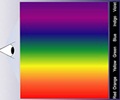Their fingers are deformed but nothing can stop their paintbrushes. For the 27 artists of the Bindu Art School near Chengalpattu, painting is a medium that transports them to a world far removed from the social stigma of leprosy.
The art school is lodged at the government leprosy colony in Bharatapuram in Chengalpattu district, some 55 km from Chennai. It is there that the artists - all of whom have been cured of leprosy - paint their hearts out.Carefully holding their brushes, which are secured to their fingers with rubber bands, they completely forget the indignities heaped on them by a society that wrongly believes the disease is contagious.
One of the artists, a former handloom worker, Arumugam, who was forced to take to begging when he was afflicted with the disease, said he had stopped dreaming of earning with dignity.
"I am so happy today. I realise I can also be creative. And at night when I sleep, I dream of colours," he said.
Other artists like 77-year-old T.S. Srinivasan and 58-year-old Rani Aandi echo similar feelings.
"Arumugam is one of the artists whose paintings are very popular, and we have sold many of his paintings," Padma Venkataraman, who runs the art school, told IANS.
Advertisement
"Verner is a multimedia specialist and we used to do some activities together in Vienna. After I came back to India in 1995-96, he visited me and expressed his desire to come and see some of the leprosy colonies," said Padma, who works for the rehabilitation of the leprosy affected.
Advertisement
Donier suggested an art school.
"Initially I was surprised. Since he is an artist, I kept wondering what kind of help could he offer. But when he came up with the idea of an art school...that was it. Bindu was born," Padma said.
That was back in 2005. But to say that an enthusiastic initiation was all that was needed would be far from the truth. Shunned by society and dejected, the leprosy patients needed a lot of convincing to take up the paintbrush.
"Initially the response was very lukewarm. All that they kept saying was 'We have never touched a brush in our lives, we have deformities, we have clawed hands, fingers, we can't even sit for long stretches...what can we do?'
"After a lot of persuasion and counselling we succeeded in getting six people to start with. But within a month's time, there was a big demand and we had 27 people eager to paint and work with us," Padma said.
People meditate for 15 minutes before the morning and afternoon sessions. After that, their imagination runs wild and their ideas begin to spill on to their canvases.
Initially they were simply given sheets of paper and only two colours - black and white.
In Donier's words, "there were no rules, or any such thing as good or bad. Nor did they have to get into any technical details of art. They were free to paint anything".
Mountains, trees, flowers, gods and goddesses came alive as the students let themselves go. Three weeks later, another colour was given to them - blue. Yellow was next and finally red.
In March 2006, the paintings saw the light of day in an exhibition in Chennai. For the first time, the spotlight was on Bharatapuram's artists.
But that was just the beginning. In their first exhibition in Chennai, each of their paintings was sold for Rs.2,000. In their second exhibition, which was organised at the Austrian ambassador's residence in Delhi, their work was sold for Rs.5,000 per piece.
"And the third exhibition was held in Vienna, in one of the famous art galleries called the Cons Stahle. Not only was it very well received but the paintings were also sold for $200 per painting!" Padma added.
"We are even thinking of promoting it as Leprosy Art - who knows, maybe because of the deformities, some of the strokes are different. People really appreciate the work. It's not sympathy but genuine appreciation."
One artist summed up her experience thus: "For the past 30 years we have been leprosy patients, but now we feel so normal."
Source-IANS
VEN/C







